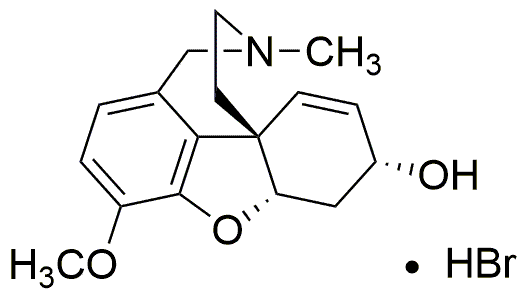Galanthamine hydrobromide from Lycoris sp. is widely utilized in research focused on:
- Alzheimer's Disease Treatment: This compound is primarily used in the management of Alzheimer's disease, enhancing cognitive function by inhibiting acetylcholinesterase, an enzyme that breaks down acetylcholine, a neurotransmitter crucial for memory and learning.
- Neuromuscular Disorders: It has applications in treating neuromuscular disorders, such as myasthenia gravis, by improving neuromuscular transmission and muscle strength, providing patients with better quality of life.
- Research in Neuropharmacology: Galanthamine is a valuable tool in neuropharmacological studies, helping researchers understand the mechanisms of neurotransmission and the effects of cholinergic drugs on the nervous system.
- Potential in Pain Management: Emerging studies suggest its potential in pain management, particularly in neuropathic pain, due to its neuroprotective properties and ability to modulate pain pathways.
- Botanical Research: As a natural alkaloid derived from Lycoris species, it is also used in botanical studies to explore the pharmacological properties of plant-derived compounds, contributing to the field of natural product chemistry.
Informations générales
Propriétés
Sécurité et réglementation
Applications
Galanthamine hydrobromide from Lycoris sp. is widely utilized in research focused on:
- Alzheimer's Disease Treatment: This compound is primarily used in the management of Alzheimer's disease, enhancing cognitive function by inhibiting acetylcholinesterase, an enzyme that breaks down acetylcholine, a neurotransmitter crucial for memory and learning.
- Neuromuscular Disorders: It has applications in treating neuromuscular disorders, such as myasthenia gravis, by improving neuromuscular transmission and muscle strength, providing patients with better quality of life.
- Research in Neuropharmacology: Galanthamine is a valuable tool in neuropharmacological studies, helping researchers understand the mechanisms of neurotransmission and the effects of cholinergic drugs on the nervous system.
- Potential in Pain Management: Emerging studies suggest its potential in pain management, particularly in neuropathic pain, due to its neuroprotective properties and ability to modulate pain pathways.
- Botanical Research: As a natural alkaloid derived from Lycoris species, it is also used in botanical studies to explore the pharmacological properties of plant-derived compounds, contributing to the field of natural product chemistry.
Documents
Fiches de données de sécurité (FDS)
La FDS fournit des informations de sécurité complètes sur la manipulation, le stockage et l’élimination du produit.
Spécifications du produit (PS)
Le PS fournit une description complète des propriétés du produit, notamment sa composition chimique, son état physique, sa pureté et les exigences de stockage. Il détaille également les plages de qualité acceptables et les applications prévues du produit.
Certificats d'analyse (COA)
Recherchez des certificats d'analyse (COA) en saisissant le numéro de lot du produit. Les numéros de lot et de lot se trouvent sur l'étiquette d'un produit, après les mots « Lot » ou « Lot de fabrication ».
Numéro de catalogue
Numéro de lot/série
Certificats d'origine (COO)
Ce certificat d'exploitation confirme le pays dans lequel le produit a été fabriqué, et détaille également les matériaux et composants utilisés et s'il est issu de sources naturelles, synthétiques ou autres sources spécifiques. Ce certificat peut être requis pour les douanes, le commerce et la conformité réglementaire.
Numéro de catalogue
Numéro de lot/série
Fiches de données de sécurité (FDS)
La FDS fournit des informations de sécurité complètes sur la manipulation, le stockage et l’élimination du produit.
DownloadSpécifications du produit (PS)
Le PS fournit une description complète des propriétés du produit, notamment sa composition chimique, son état physique, sa pureté et les exigences de stockage. Il détaille également les plages de qualité acceptables et les applications prévues du produit.
DownloadCertificats d'analyse (COA)
Recherchez des certificats d'analyse (COA) en saisissant le numéro de lot du produit. Les numéros de lot et de lot se trouvent sur l'étiquette d'un produit, après les mots « Lot » ou « Lot de fabrication ».
Numéro de catalogue
Numéro de lot/série
Certificats d'origine (COO)
Ce certificat d'exploitation confirme le pays dans lequel le produit a été fabriqué, et détaille également les matériaux et composants utilisés et s'il est issu de sources naturelles, synthétiques ou autres sources spécifiques. Ce certificat peut être requis pour les douanes, le commerce et la conformité réglementaire.


